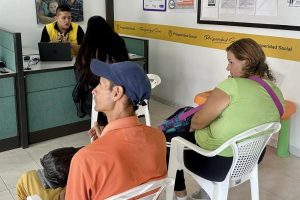The conversation began with a brief historical overview of the inclusion of gender perspectives in water policies at the international level, which dates back to 1975 with the World Conference of the International Year of Women in Mexico City, and continues with the relevance of the 2030 Agenda, which includes concrete goals to advance both gender equality (SDG 5) and access to clean water and safe sanitation (SDG 6).
Regarding the current situation in Latin America and the Caribbean, Ms. Saravia addressed the lack of access to safe drinking water and sanitation as a critical issue. Approximately 25% of the population in the region lacks access to safely managed drinking water, and 51% does not have safe sanitation. This gap has significant adverse effects on women and girls, exposing them to security risks, diseases and obstacles to accessing education. The lack of adequate facilities particularly affects women in rural areas and those with lower levels of education, impeding their participation in community life and economic autonomy. In addition, Ms. Saravia underlined the unequal burden of domestic work faced by women, who spend 2.8 hours for every hour of unpaid work compared to men. Limited access to water also impacts women’s ability to actively participate in decision-making and contributes to food insecurity in rural communities. The figures highlight the urgent need to integrate a gender perspective into water and sanitation management to improve the quality of life of women and girls in the region. This approach not only promotes equity, but also has the potential to increase economic growth in the region.
Ms. Silvia Saravia Matus explored the importance of gender-sensitive water policies in governance and women’s participation in water management. She stressed that they are essential to promote greater inclusion and equity. In the framework of the Regional Water Dialogues for Latin America and the Caribbean, the need to close investment gaps to reduce the disproportionate impact on women and girls was underlined. She emphasized that the inclusion of the gender perspective in public policies not only improves the effectiveness of investment initiatives, but also prevents problems such as poor location of infrastructure. She cited the example of toilets in rural areas of Bolivia, where the lack of consultation with women led to facilities that they could not use due to their characteristics.
In addition, Ms. Saravia addressed persistent challenges, such as the lack of sufficient investment in policies that truly close existing gaps. Despite efforts, current policies often do not align with the real needs of women and do not effectively address the lack of access to safe drinking water and sanitation. She also mentioned that many gender-sensitive agricultural policies often do not include specific technical training for women, perpetuating inequality; as well as the importance of having sex-disaggregated data for more effective intervention in public policies related to water. These data allow for more precise planning and adequate monitoring, facilitating the allocation of budgets that promote gender equity. She also elaborated on the need for inclusive education and training for both women and men, with the aim of fostering a culture of equity in society. The diversity of women, including rural, indigenous and Afro-descendant women, must be considered to design policies that respond to the specific needs of each group and that allow progress towards a culture of dignity and equity. This comprehensive vision is essential to closing gender gaps and ensuring sustainable development in the region.
The event concluded with a special thanks to the organizers and the community for creating much-needed spaces for reflection on gender equity and water management on the international stage. These types of dialogues are essential to continue moving towards inclusive and sustainable water management.





![[Img #74683]](https://thelatestnews.world/wp-content/uploads/2024/12/The-main-mistakes-to-avoid-when-betting-on-electronic-sports-150x150.jpg)









Add Comment